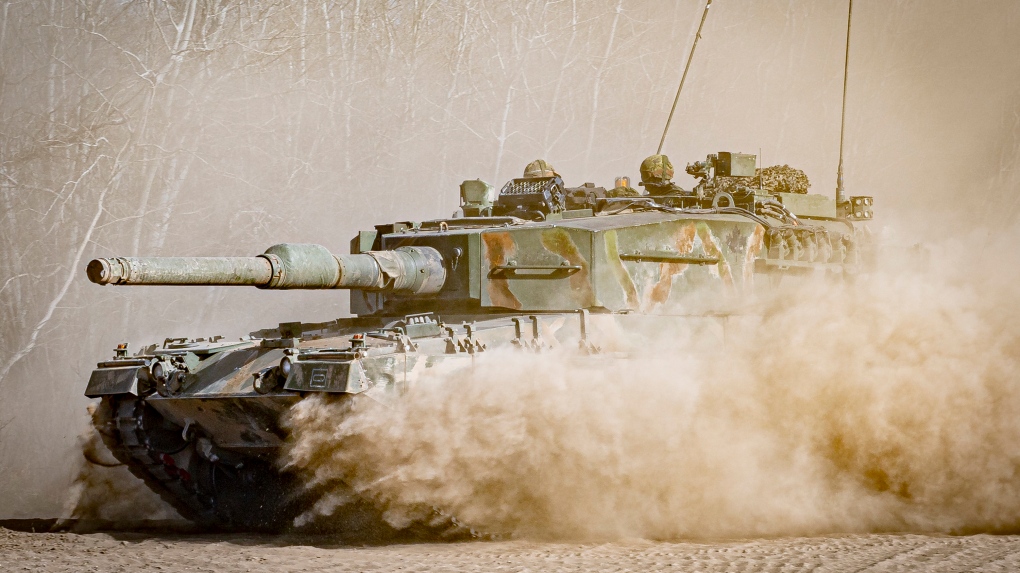Defence insiders sound alarms on state of Canadian military
Citing everything from troop shortages to dwindling ammunition stocks to aging equipment and technology, a growing number of current and former defence officials are raising alarms about the state of the Canadian military.
Even by its own estimates, only 61 per cent of the Canadian Armed Forces is considered ready for operations, according to the most recent data. In an increasingly volatile world, some say that’s serious cause for concern.
“On the readiness of the Canadian Armed Forces, I’d characterize it as it’s in decline somewhat precipitously and in a bit of a vicious circle,” Royal Canadian Air Force (RCAF) retired lieutenant-general Christopher Coates said in an interview with CTVNews.ca. “My impression is that the situation is significant today, and that it that it merits some good debate by our nation.”
Why this matters
Article 5 of the North Atlantic Treaty Organization (NATO) requires member states to assist allies if they are attacked. While such threats may have seemed unlikely a few short years ago, Russian aggression in Ukraine has brought war directly to NATO’s borders, producing the most serious danger to the security alliance in decades, and real fears that Canada, the U.S. and 29 other European NATO members could become embroiled in a broader war.
The increasingly troubled state of the Canadian Armed Forces came into sharp focus in late September, when Chief of the Defence Staff Gen. Wayne Eyre appeared before Parliament’s national defence committee after the military was asked to trim nearly $1 billion in spending.
“There’s no way that you can take almost a billion dollars out of the defence budget and not have an impact, so this is something that we’re wrestling with now,” Canada’s top military commander warned lawmakers on Sept. 28. “Our people see the degrading, declining security situation around the world, so trying to explain this to them is very difficult.”
Eyre also spoke about ammunition shortfalls, and how being called to respond to domestic natural disasters is increasingly “affecting our readiness to do our primary function.”
“I am very concerned about our ammunition stocks,” Eyre added. “If we were to consume munitions at the same rate that we’re seeing them consumed in Ukraine, we would be out in days in some cases, and it would take years to restock.”
 Petty Officer Second Class Russell Kennedy, a boatswain on HMCS HALIFAX fires a SIG Sauer P320 on the flight deck as part of a force protection shoot during Operation REASSURANCE on 20 April 2022 (Pte Connor Bennett / Canadian Armed Forces photo)
Petty Officer Second Class Russell Kennedy, a boatswain on HMCS HALIFAX fires a SIG Sauer P320 on the flight deck as part of a force protection shoot during Operation REASSURANCE on 20 April 2022 (Pte Connor Bennett / Canadian Armed Forces photo)
‘Multiple calls for action’
Royal Canadian Navy Commander Vice-Admiral Angus Topshee shared his concerns in a November video.
“The (Royal Canadian Navy) faces some very serious challenges right now that could mean we fail to meet our force posture and readiness commitments in 2024 and beyond,” Topshee said in a five-minute YouTube post. “The (Royal Canadian Navy) is at a critical state, with many occupations experiencing shortages of 20 per cent and higher.”
Similar alarms have also recently been raised by other defence and security insiders, including air force commander Lt.-Gen. Eric Kenny, Canadian Joint Operations Command Commander Vice-Admiral Bob Auchterlonie, former CSIS director and national security adviser Richard Fadden, and retired Vice Chief of the Defence Staff retired lieutenant-general Guy Thibault.
Adding to these voices, Coates served as the deputy commander and highest ranking Canadian at Norad – the joint Canada-U.S. continental defence group – between 2018 and 2020.
“I really believe that Canada is failing to provide the quality and quantity of defence that’s needed for the current and emerging geopolitical situation,” Coates told CTVNews.ca from Ottawa in February. “Failure to address that, I believe, could have significant repercussions for Canada’s global standing, our economy, our prosperity, our security and our sovereignty.”
 A Leopard 2A4 tank from Lord Strathcona’s Horse (Royal Canadians) travels on the Black Route of the 3rd Canadian Division Support Base Garrison Wainwright Training Centre in preparation for Exercise MAPLE RESOLVE 21, on April 30, 2021. (Sailor First Class Camden Scott, Canadian Armed Forces photo)
A Leopard 2A4 tank from Lord Strathcona’s Horse (Royal Canadians) travels on the Black Route of the 3rd Canadian Division Support Base Garrison Wainwright Training Centre in preparation for Exercise MAPLE RESOLVE 21, on April 30, 2021. (Sailor First Class Camden Scott, Canadian Armed Forces photo)
Conference of Defence Associations Institute Executive Director Youri Cormier says the “extremely dire” situation is “the product of decades of consistent underfunding, by government after government.”
“Canadians have always felt like a country with no natural predators and believed that our three oceans and having a friendly superpower to the south would protect us,” Cormier told CTVNews.ca. “However, it does tell you something about the seriousness of the problem when multiple calls for action are raised publicly one after the other. It suggests that messages are perhaps not adequately being heard and acted upon through formal internal channels.”
Is Canada prepared?
Canada’s Department of National Defence outlined the issue in its 2022-23 Departmental Results Report, which was released in December.
According to its estimates, about half of all military equipment was considered ready for training and operations last year, including 56 per cent of land vehicles, 51.2 per cent of key maritime fleets and just 43.9 per cent of aircraft.
Overall, 61 per cent of force elements were considered ready for operations, while only 40 per cent of operations were capable of being conducted concurrently – both below 100 per cent targets. Such shortcomings even contributed to Canada skipping a major NATO air defence exercise in June.
“Based on overall readiness levels, the CAF is currently unable to conduct multiple operations concurrently,” a note in the report explains. “Readiness of CAF force elements has continued to decrease over the course of the last year aggravated by decreasing number of personnel and issues with equipment and vehicles.”
Speaking in September, Eyre said the Canadian forces were also short nearly 15,500 regular and reserve forces, and that almost 10,500 soldiers were in training and not ready for deployment.
Rob Huebert is a political science professor and a senior research fellow with the Centre for Military, Security and Strategic Studies at the University of Calgary.
“I think that there is a growing recognition, and one that many have seen coming for a very long time, that we are in one of the most dangerous (periods of) lack of preparation for any type of international geopolitical threat at any level,” Huebert told CTVNews.ca in February. “When we look right across the board in terms of equipment, in terms of training, in terms of personnel, the numbers come back and are to the degree that they should scare most Canadians.”
‘The endgame is serious’
While current and former security insiders raise alarms about the military’s ability to respond to new and emerging threats, Canada has also come under fire from its allies for long falling short of a commitment by NATO members to spend two per cent of its gross domestic product (GDP) on defence.
“Over the last 10 years, we’ve moved from three countries meeting that target to 18, with more to come, and those that aren’t meeting it right now have a plan to get there, except for Canada,” U.S. ambassador to NATO Julianne Smith told CTV Question Period on Feb. 22.
Canada spent an estimated 1.38 per cent of its GDP on defence in 2023, according to NATO data, up from 1.01 per cent in 2014. Despite the increase, Canada is still ranked 25th out of 30 NATO states – not including new and soon-to-be members Finland and Sweden. Only 11 countries met the two per cent target in 2023, led by Poland, the U.S. and Greece.
“Canada should, as all other allies, deliver on the pledge to invest two per cent, because we need that in a more dangerous world,” NATO Secretary-General Jens Stoltenberg told CTV News Channel’s Power Play on Feb. 20.
Canada, however, has a larger GDP than many other NATO members, and its total military spending in 2023 came in at an estimated US$24.5 billion, putting Canada in seventh place just behind Italy and Poland. According to new data from Canada’s Parliamentary Budget Officer, capital spending on defence will reach $214.8 billion through 2037, with inflation, delays and new procurement projects driving up costs from a previous estimate of $164 billion.
Russia’s invasion of Ukraine has caused many European countries to increase military spending and bolster their defences as the possibility of further escalation and a broader war becomes more palpable. Coates says threats to the rules-based international order don’t end with Russia.
“We live in a changing and increasingly complex and competitive world,” Coates explained. “Look at the way India is behaving, look at the way China is behaving: that’s not co-operative behaviour, it’s coercive behaviour, and it doesn’t end with just a few cyberattacks. The endgame is serious. We as Canadians are not prepared for it.”
Canadian Deputy Prime Minister Chrystia Freeland seemed to address the root of the issue when defending Canada’s support for Ukraine. Speaking in French to reporters in Ottawa on Feb. 7, Freeland said the Ukraine conflict “is also a war for us.”
“We need to understand what the goal of Vladimir Putin is,” Freeland continued. “He wants a world in which it is the strongest countries with the largest armies that are able to control everyone else. This would not be a good world for Canadians.”
Is new spending falling short?
When questioned about its commitment to defence, the federal government routinely cites troop deployments to NATO members like Latvia, new equipment like P-8A Poseidon aircraft, and long-term announcements like the purchase of new F-35 fighter jets and $38.6 billion for Norad upgrades.
“We’re taking bold steps to improve the readiness and long-term health of Canada’s military,” a national defence spokesperson told CTVNews.ca. Those steps also include efforts to increase enlistment like accepting permanent residents, better addressing the mental well-being of service members, and modernizing with new gear.
“We will continue to make sure that the women and men of the Canadian Armed Forces — and the people around the world, our allies, who rely on them — will continue to get the equipment and the support they need,” Prime Minister Justin Trudeau told reporters in Poland on Feb. 26, The Canadian Press reported.
While Coates and Huebert say these are steps in the right direction, they are also largely future solutions to defence gaps and equipment issues that exist today.
“I think there is great possibility that we’re going to wait several years to get equipment that is fit for today or yesterday’s operations, and maybe not fit for the kind of environment that they’re going to find themselves in,” Coates said. “The whole idea that we’re going to create a military fit for purpose in the next decade, 2030 and beyond, by purchasing some equipment today, that that is not sufficient… Even our non-superpower allies are spending effort today to envision the after-next capabilities that they’re going to require.”
Huebert points to three factors that have led to Canada’s current defence deficit: an overreliance on our American neighbours for security; a belief that world became more peaceful after the Cold War; and a perceived lack of public support for military spending.
“The bottom line is, is what we’ve seen a total lack of is any serious leadership on the issue of the needs that we have,” Huebert said. “What we really need is, we need to have the political elites, both Liberals and Conservative, take geopolitical and military security as seriously as we see the Liberals take environmental security.”
Conservative defence critic and Manitoba MP James Bezan has been tracking the issue through Parliament’s national defence committee.
“We need a massive overhaul of how Canada does military procurement, and how we approach national security, but most importantly we need a prime minister who cares about these issues,” Bezan told CTVNews.ca. “Entire air squadrons are being shut down because they don’t have enough personnel. Our submarines are barely in the water and our warships are aging faster than expected and their plan to replace them is still years away.”
View original article here Source









